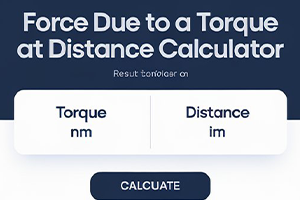Force Due to a Torque at Distance Calculator

Formula:
Torque (tau) is calculated using the formula:
(tau = F x r)
Where (F) is the force in kgf and (r) is the radius in meters.
Frequently Asked Questions (FAQs)
1. What is torque?
Torque is a measure of rotational force that causes an object to rotate or twist around a pivot point.
2. How is torque calculated?
Torque (τ) is calculated using the formula τ = F x r, where F is the force applied and r is the distance from the axis of rotation to where the force is applied.
3. What units are commonly used for measuring torque?
Common units for measuring torque include Newton-meters (Nm), kilogram-force meters (kgf·m), and foot-pounds (ft·lb).
4. What is the difference between force and torque?
Force is a push or pull that causes an object to change its state of motion, while torque is a rotational force that causes an object to rotate.
5. Why do we need to know the distance from the axis of rotation?
The distance from the axis of rotation affects how much rotational force (torque) is generated by a given linear force.
6. Can I use this calculator for any type of torque calculation?
This calculator is specifically designed for calculating force due to torque at a given distance. For other types of torque calculations, you may need different formulas or tools.
7. How do I choose the correct unit for my calculation?
Choose units that match your input values. For example, if your force is in Newtons and your distance is in meters, use Nm as your unit for torque.
8. What happens if I enter negative values for force or distance?
Entering negative values may not provide meaningful results since physical forces and distances are typically positive quantities in this context.
9. Can this calculator handle large numbers?
The calculator should be able to handle large numbers within reasonable limits; however, extremely large values might lead to precision issues.
10. How accurate are the results from this calculator?
The results are accurate based on the input values and assumptions made about the formula τ = F x r. However, real-world applications may involve additional factors affecting accuracy.
11. What are some common applications of this formula?
This formula is commonly used in engineering fields such as mechanical engineering, automotive engineering, and robotics to calculate rotational forces.
12. Can I use this formula for non-linear systems?
This formula assumes linear relationships between force and distance; for non-linear systems, more complex models may be required.
13. How does friction affect torque calculations?
Friction can reduce the effective torque by opposing rotational motion; however, this calculator does not account for frictional losses.
14. Can I save my calculations for later reference?
Currently, this calculator does not have a save feature; you will need to take note of your results manually or use external tools to save them.
15. Are there any limitations to using this online calculator?
Yes, there may be limitations related to browser compatibility, input range limitations, and potential errors due to rounding or precision issues.

 Pneumatic-Hydraulic
Pneumatic-Hydraulic  Materials-Weight
Materials-Weight
 Miscellaneous Cal's
Miscellaneous Cal's Mechanics
Mechanics